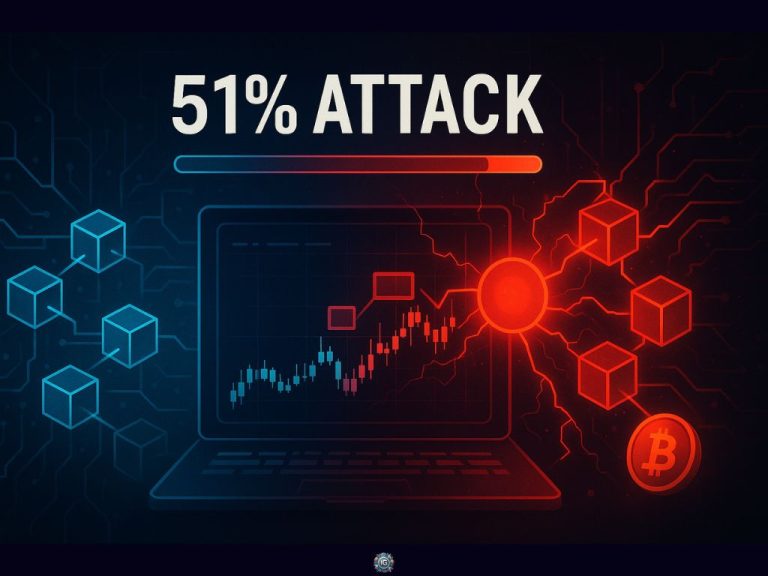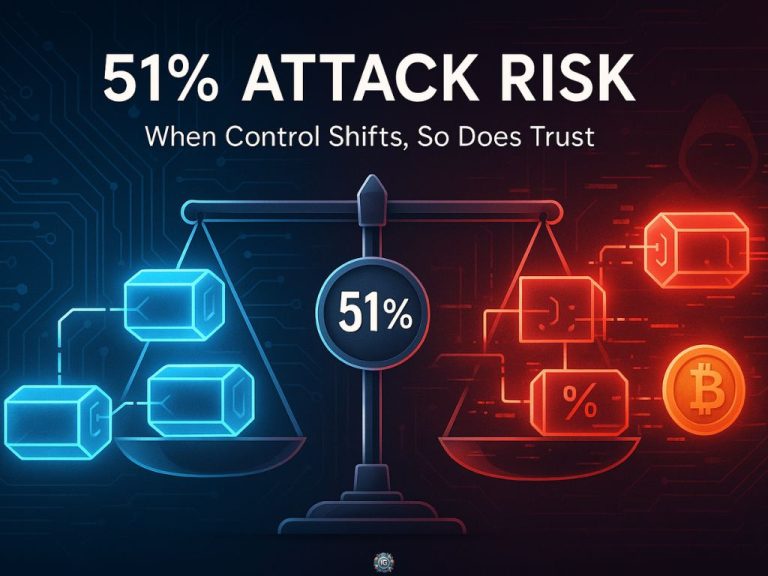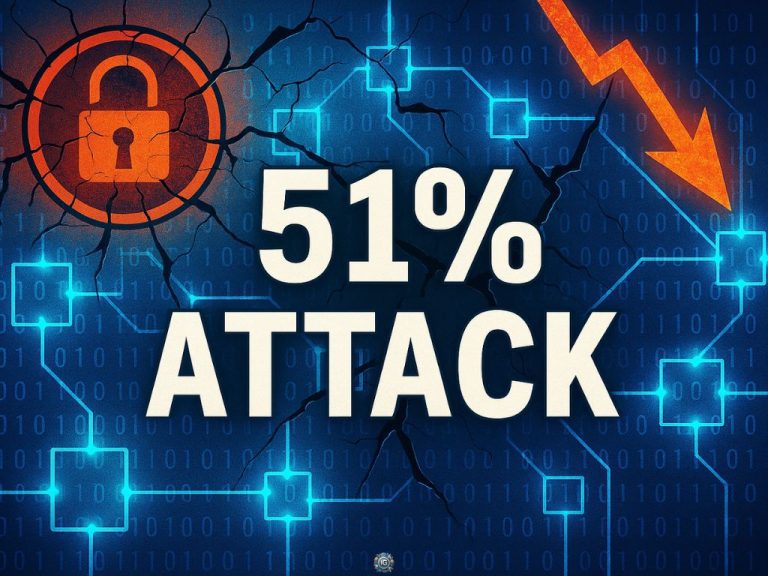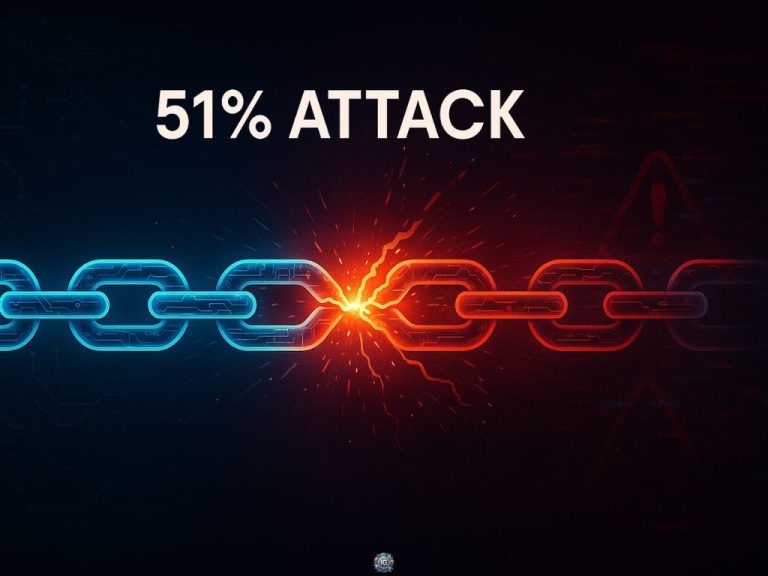What if your $10,000 crypto transfer suddenly vanished — not from your wallet, but from the blockchain itself?
The transaction was real. You saw the confirmation. Then, hours later, it was like it never existed.
That’s not science fiction. That’s a 51% attack — one of the most dangerous, misunderstood, and ignored threats in crypto today.
It’s not about phishing. It’s not malware. And it’s not some guy in a hoodie hacking your phone. This is something much more fundamental.
A 51% attack targets the very core of blockchain’s promise: that once a transaction is recorded, it’s permanent, immutable, and irreversible.
But when one group gains majority control of a blockchain’s infrastructure, everything changes. They don’t just participate in the network — they control it. They can reverse transactions. Double-spend coins. Freeze activity. Exclude other miners. Erase history.
And the worst part? Most people in crypto don’t really understand how it works. They assume Bitcoin is invincible. They trust Ethereum’s decentralization. And they never question the smaller altcoins that quietly run on fragile foundations.
This article breaks down exactly how a 51% attack happens, where it’s already occurred, and why it’s not just a theoretical risk. You’re about to learn what most crypto users don’t — and why decentralization isn’t a buzzword… it’s your last line of defense.

Key Takeaways
- A 51% attack happens when one entity gains control of more than half of a blockchain’s mining or validation power.
- This control allows the attacker to reverse transactions, double-spend coins, and block new activity — without hacking a single wallet.
- Bitcoin and Ethereum are difficult to attack due to their massive decentralization, but smaller chains remain highly vulnerable.
- Real-world 51% attacks have already occurred on coins like Ethereum Classic and Bitcoin Gold, causing millions in losses.
- It’s not just a tech issue — a successful attack can erase trust, halt trading, and cripple an entire blockchain economy.
What Is a 51% Attack, Really?
At its core, a 51% attack isn’t some exotic hacker move. It’s a hostile takeover of the most important layer in any blockchain: the consensus mechanism.
Blockchains are designed to be trustless. Instead of relying on a central authority, they rely on math, consensus, and the assumption that no single party will ever control the majority of the network. But what happens when someone does?
A 51% attack occurs when a miner (or group of miners) gains control of more than half of the total computational power in a Proof of Work system — or a majority of staking authority in a Proof of Stake chain. With that control, they can override the consensus, manipulate the ledger, and decide which transactions get approved… and which disappear.
Think of it like this: imagine a group of accountants is hired to validate every financial transaction in a city. They keep everyone honest because no one can cheat without being outvoted. Now imagine one mega-corporation hires more than half of the accountants. Suddenly, that company can “verify” fraudulent records, erase payments, or make it look like you paid twice — even if you didn’t.
That’s exactly what a 51% attack enables. It doesn’t break the blockchain — it uses the blockchain against itself.
And the scariest part? You might never know it happened until it’s too late.
Next, check out our Crypto for Beginners Guide.

How a 51% Attack Works Step by Step
A 51% attack doesn’t require genius. It requires brute force, timing, and one critical advantage: majority control of the network’s consensus mechanism.
Here’s how it unfolds — not in theory, but in cold, calculated steps:
1. The Attacker Builds Up Majority Power
Whether it’s through raw mining power (Proof of Work) or staked assets (Proof of Stake), the attacker amasses more than 50% of the network’s control. This can be done by pooling resources, renting hash power, or exploiting validator concentration.
2. They Secretly Mine a Shadow Chain
While the honest network continues processing transactions, the attacker starts working on a private version of the blockchain — one where they control every block and can include (or exclude) any transaction they choose.
3. They Broadcast a Fraudulent Transaction
To the public chain, everything looks normal. The attacker might send coins to an exchange or vendor and receive goods, services, or stablecoins in return.
4. They Unleash the Shadow Chain
Once the fraudulent transaction is confirmed and they’ve extracted value, the attacker releases their private chain — which now becomes the longest chain. By the rules of blockchain consensus, the network accepts it as the new truth.
5. Double-Spending Complete, Chaos Begins
The original transaction is erased. The vendor or exchange is left with nothing. Meanwhile, the attacker walks away with both the goods and their coins — used twice, with the network’s full approval.
But it doesn’t stop there. With majority control, the attacker can:
- Censor specific users
- Block certain transactions
- Prevent new blocks from forming
- Undermine the trust that keeps the network alive
It’s not just theft — it’s consensus terrorism.
And in smaller blockchains, it can happen in hours — not weeks.

Real Examples of 51% Attacks (And What Happened)
You don’t have to imagine the damage a 51% attack can cause — it’s already happened. Multiple times. Millions lost. Trust shattered. And in most cases, the world barely noticed.
Here are just a few moments when blockchains got blindsided:
🧨 Ethereum Classic (ETC) — 2019
In January 2019, Ethereum Classic suffered a massive 51% attack that rewrote history — literally. Over 100,000 ETC (worth ~$500,000 at the time) were double-spent after attackers reorganized blocks and reversed confirmed transactions. The fallout? Exchanges like Coinbase froze ETC trades, and confidence in the project cratered.
Even worse, it didn’t stop there. Multiple follow-up attacks hit the network again in August 2020, proving just how fragile smaller chains can be when they don’t adapt quickly enough.
💥 Bitcoin Gold (BTG) — 2018 and 2020
Bitcoin Gold, a fork of Bitcoin, was hit with not one but two major 51% attacks. In 2018, attackers pulled off a $18 million heist through double-spending, targeting exchanges and draining value in hours. The dev team promised improvements. Then in 2020 — it happened again.
Clearly, security patches and promises aren’t enough when your network can be hijacked by rented hashing power.
⚠️ Vertcoin (VTC) — 2018
Vertcoin was created to resist ASIC dominance… but it wasn’t immune to manipulation. In December 2018, a 51% attack reorganized over 300 blocks and double-spent more than $100,000. The attack was executed using NiceHash — a marketplace for buying temporary mining power. In other words: the attackers didn’t even need to own hardware.
These weren’t isolated flukes. They were warnings — and most people ignored them.
The takeaway? If your chain is small, and your consensus isn’t battle-tested, it’s a sitting duck.
And with the rise of hashrate marketplaces and validator centralization, these attacks are only getting easier to execute.

Why Some Blockchains Are More Vulnerable Than Others
Not all blockchains are built equally — and not all are defended equally, either.
Bitcoin has an army behind it. Ethereum has global validators, massive liquidity, and eyes everywhere. But many altcoins? They’re running on fumes — and ripe for exploitation.
Here’s what makes a blockchain dangerously vulnerable to a 51% attack:
1. Low Hashrate or Low Stake Participation
The smaller the network, the easier it is to take over.
In Proof of Work chains, if the total hashrate is low, an attacker can rent mining power from services like NiceHash and overwhelm the network — without owning a single machine.
In Proof of Stake systems, if staking is concentrated or underutilized, a few wealthy validators can quietly seize control.
2. Centralized Mining or Staking Pools
Even large chains can tip toward danger if control clusters.
When just a handful of mining pools control the majority of block production, it only takes a few actors — or even one compromised pool — to create a vulnerability.
The same goes for staking: a network that looks decentralized might have most of its stake locked up in just a few validators.
3. Infrequent Block Production
Slow block times give attackers breathing room.
If it takes minutes to add a block, an attacker can mine or validate a secret chain in parallel without being detected immediately.
The slower the chain, the more time an attacker has to manipulate it behind the scenes.
4. Lack of Active Monitoring
Some blockchains don’t invest in active surveillance of chain reorganizations, validator behavior, or mining concentration.
That means attacks can happen, execute, and settle before anyone even notices. By the time the alarms go off, the funds are long gone.
5. Economic Irrelevance
This one hurts — but it’s true. If a project has low adoption, low liquidity, or weak community support, exchanges are more likely to ignore it after an attack.
That makes recovery harder, reputational damage deeper, and incentives for attackers even higher. Why not rob a chain no one’s watching?
The brutal truth? Some chains are sitting targets — not because they’re broken, but because they’re too small to defend themselves.
And attackers know exactly which ones they are.

Can Bitcoin or Ethereum Be Hit? (Uncomfortable Truths)
The short answer? It’s extremely unlikely.
The long answer? It’s not impossible.
Most people believe Bitcoin and Ethereum are immune to 51% attacks — and in practical terms, that belief mostly holds. Their sheer scale, decentralization, and cost of attack make them highly resilient.
But if you look closer… the story gets darker.
Bitcoin: Too Big to Attack… For Now
Bitcoin’s hash rate is colossal. Attempting to gain 51% control would require billions of dollars in hardware, access to massive energy infrastructure, and logistics rivaling that of a nation-state.
And even then, the economic incentive is questionable — any successful attack would tank Bitcoin’s price, destroying the very value the attacker just exploited.
But here’s the uncomfortable truth: Bitcoin mining is more centralized than most realize.
A handful of major pools control a large percentage of the hash rate. If these pools were compromised — or incentivized to collude — a temporary attack becomes mathematically possible.
And with the growth of cloud-based mining and ASIC-as-a-Service platforms, access to power is becoming increasingly liquid.
Ethereum: Safer After The Merge, But Not Bulletproof
Ethereum’s move to Proof of Stake reduced its exposure to hashrate-based 51% attacks, but it introduced new attack surfaces.
Validators can still collude. Stake concentration is real — large exchanges and institutions control significant percentages of staked ETH. If those entities ever aligned (intentionally or not), network consensus could be swayed.
Slashing penalties help disincentivize bad actors, but in high-value scenarios — say, a geopolitical attack — some players may absorb the losses for larger gains.
And in moments of high congestion or political tension, trust in the system’s decentralization could waver.
So What’s the Real Risk?
- Is a 51% attack likely on Bitcoin or Ethereum? No.
- Is it theoretically possible? Yes.
- Is absolute immunity a myth? 100%.
The takeaway? Even the strongest blockchains depend on constant vigilance — and decentralization is a moving target.

How Blockchain Developers Fight Back
A 51% attack doesn’t just damage a chain — it humiliates it. Trust evaporates. Exchanges pull support. Users flee. And developers are left to explain how a “secure, decentralized system” got rewritten like a Word doc.
So how do serious projects defend themselves?
Here’s how the best blockchains are building their armor:
1. Checkpointing
Some blockchains lock in certain blocks as “final” after a specific number of confirmations. These checkpoints make it nearly impossible for an attacker to reorganize the chain beyond that point — even with majority control.
It’s like a tripwire baked into the protocol. You can mess with the recent past… but not ancient history.
2. Slashing and Penalties (Proof of Stake Defense)
In PoS systems like Ethereum, validators who act maliciously can have a portion of their staked assets slashed — burned or redistributed as punishment.
This makes 51% attacks incredibly expensive, because you don’t just risk being caught — you risk losing everything you put up to cheat in the first place.
3. Hybrid Consensus Models
Some blockchains combine multiple validation mechanisms — like PoW + PoS or PoS + Byzantine Fault Tolerance — to diversify control. This makes it significantly harder for a single entity to dominate all layers of consensus at once.
Think of it like a multi-lock vault: even if you get past one layer, the next one is waiting.
4. Mining Pool Transparency and Monitoring
For PoW chains, transparency matters. Developers now actively monitor mining pool distribution and alert the community when one pool edges too close to 50%.
In 2014, when GHash.io approached 51% of Bitcoin’s hash rate, the community reacted fast. Social pressure, PR fallout, and user migration forced it to scale back.
Social consensus saved technical consensus.
5. Fast Block Times and High Finality
Some chains are designed to finalize transactions faster, leaving attackers with less room to secretly mine a shadow chain.
With rapid block production and finality checkpoints, the opportunity window for manipulation shrinks dramatically.
The bottom line? You can’t completely prevent a 51% attack — but you can make it economically suicidal and logistically nightmarish.
And that’s the point: The best defense is not just code — it’s community vigilance, economic disincentives, and systems that punish betrayal harder than they reward it.

The Future of Blockchain Security: Are 51% Attacks Getting Easier?
Here’s the uncomfortable reality no one in crypto wants to admit: technology isn’t just protecting blockchains — it’s also empowering attackers.
The tools are getting smarter. The costs are getting lower. And the incentives? Bigger than ever.
Let’s break it down.
🔌 Rented Hashpower = On-Demand Attack Power
You no longer need to own a warehouse full of miners to launch a 51% attack. Platforms like NiceHash let you rent massive amounts of computational power by the hour.
Which means if a chain has low hashrate and high token value, an attacker can perform a full-on ledger rewrite using someone else’s machines — no long-term infrastructure, no massive capital, no fingerprints.
🧠 AI + Automation = Smarter Exploits
As AI becomes more integrated with blockchain analytics, it’s not just defenders who benefit.
Sophisticated attackers can use AI to:
- Detect undersecured networks
- Automate private chain mining
- Time releases for max disruption
It’s cyberwarfare-as-a-service, and smaller chains are wildly underprepared.
⚠️ Centralization Creep
Ironically, many chains are trying to boost efficiency by centralizing more — fewer validators, faster finality, delegated consensus.
But this trade-off invites a chilling risk: a single point of failure.
In trying to scale fast, many projects are handing attackers the blueprint for exactly how to compromise them later.
And if a dominant exchange, validator, or hosting provider is ever breached… the consequences won’t be limited to one chain.
🪙 Token Value vs. Network Security Mismatch
The higher the market cap, the more attractive the target. But some coins have high value and low hashrate, which is like leaving a vault full of gold locked with a bicycle chain.
Unless projects scale their security with their valuation, they become honeypots for precision attacks.
🌐 Cross-Chain Risk and Collateral Damage
In a multichain world, an attack on one network can cascade into others — especially if it involves wrapped assets, cross-chain bridges, or DeFi protocols.
A 51% attack on a smaller chain could de-peg tokens on Ethereum, cause liquidations on lending platforms, or trigger protocol-wide freezes.
The future isn’t isolated chains. It’s interconnected chaos — and attackers are learning how to exploit that.
So… are 51% attacks getting easier?
Yes. More accessible, more automated and more profitable. The game is changing. And unless security evolves faster than the threat, blockchain’s biggest weakness may be baked into its own progress.

How to Protect Yourself as a User or Investor
You can’t stop a 51% attack by yourself. But you can avoid being one of its victims.
Most people don’t realize they’re vulnerable until it’s too late — after a transaction gets reversed, a token de-pegs, or an exchange halts withdrawals. The good news? With the right awareness, you can stay steps ahead of the chaos.
Here’s how to protect your assets in a landscape where trust can be rewritten block by block:
🧠 1. Don’t Blindly Trust Small Blockchains
Just because a token is listed on an exchange or hyped on social media doesn’t mean the network behind it is secure.
Check the chain’s total hashrate (PoW) or validator distribution (PoS) before making large transactions.
If one pool or wallet holds a massive share of control, that’s a red flag — even if the token is pumping.
🔍 2. Research Before You Transact
Before using a DApp, bridging assets, or trading on a new protocol, ask:
- How decentralized is the network?
- Has it ever been attacked before?
- How quickly does it finalize blocks?
- What do security audits or explorers show?
The answers might save you more than a transaction — they might save your entire stack.
🏦 3. Use Reputable Exchanges with Monitoring Tools
Top-tier exchanges like Coinbase and Binance monitor blockchain reorgs in real time and often pause withdrawals if a chain shows signs of manipulation.
Lower-tier or offshore platforms? Not so much.
When in doubt, stick with platforms that have active attack response systems — or be ready to lose access in a flash.
🚫 4. Avoid Holding Value on Fragile Chains
If you’re holding thousands of dollars on a micro-cap coin running on a barely-functioning blockchain, you’re not investing — you’re gambling.
Even if the coin survives, the next attack could leave your funds in limbo, your transactions stuck, or your holdings worthless.
Convert to stablecoins or bridge out to stronger networks if you’re not actively trading.
🧭 5. Watch What the Whales Are Doing
If large holders, validators, or major ecosystem players start moving assets off-chain, unstaking, or publicly expressing concern, pay attention.
Big players usually move before the chaos hits — and their exit signals can be early warnings you can’t afford to ignore.
This isn’t paranoia — it’s protection.
Because in crypto, the chain doesn’t have to break for you to lose everything.
Sometimes, it just has to bend in the hands of the wrong person.

FAQs (Frequently Asked Questions)
1. Can a 51% attack completely shut down a blockchain?
No — but it can make the network temporarily untrustworthy. A 51% attack doesn’t destroy the blockchain’s infrastructure. Instead, it allows attackers to manipulate transaction history, reverse payments, or block new transactions. The network remains online, but its integrity is compromised, often leading to exchange suspensions, trading halts, or user panic.
2. Has a 51% attack ever happened in real life?
Yes — multiple times. Ethereum Classic, Bitcoin Gold, and Vertcoin are just a few notable examples where attackers successfully double-spent coins and reorganized blocks. These weren’t hypothetical attacks — they resulted in millions in verified losses.
3. How much would it cost to execute a 51% attack on Bitcoin?
Estimates vary, but launching a sustained 51% attack on Bitcoin would likely cost hundreds of millions to billions of dollars in mining equipment, electricity, and infrastructure. Plus, the economic impact of damaging Bitcoin’s reputation could make the attack self-defeating. For this reason, it’s considered economically infeasible, but not technically impossible.
4. Can a 51% attack be reversed or undone?
In most cases, no. Once blocks have been reorganized and transactions erased, there’s no way to restore the original chain without full community consensus — and by then, the attacker has usually cashed out. Exchanges may take emergency action to freeze funds or reverse off-chain records, but on-chain history is final once the longest chain wins.
5. Can wallets or smart contracts protect me from a 51% attack?
Not directly. A 51% attack targets the network layer, not individual wallets or contracts. Even if your private keys are secure, the transactions you send can still be censored, delayed, or reversed at the consensus level. Smart contracts also rely on network finality — which is exactly what a 51% attack disrupts.

Conclusion: Why Decentralization Is Your Real Insurance
A 51% attack isn’t some distant edge-case buried in whitepapers — it’s the one threat that can turn a “trustless” blockchain into a system where truth is for sale.
It doesn’t take malware. It doesn’t require genius.
All it takes is control — and just 1% past half is enough to rewrite everything you thought was permanent.
Larger networks like Bitcoin and Ethereum have the scale and incentive alignment to hold the line — for now. But every smaller chain? It’s on borrowed time if it’s not constantly defending, decentralizing, and adapting.
As a user, trader, investor, or builder, your job isn’t just to buy the token.
It’s to understand the foundation it runs on — and whether that foundation could collapse with the click of a button.
Because when decentralization breaks, nothing else matters.
- Not the price.
- Not the tech.
- Not the roadmap.
Only one question will matter in that moment: Can you trust the chain you’re standing on?
🔗 Explore more crypto terms in our Cryptocurrency Glossary.
Disclaimer: This blog post is for informational purposes only and should not be considered financial advice. I am not a licensed financial advisor, and you should always do your own research or consult a professional before making any financial decisions. Cryptocurrencies are volatile and involve significant risk of loss. Past performance is not indicative of future results.